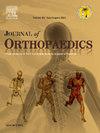Clinical outcomes of a 'patella-friendly' medial pivot total knee arthroplasty with and without patella resurfacing: A prospective randomised study
IF 1.5
Q3 ORTHOPEDICS
引用次数: 0
Abstract
Background
Advances in knee implant design brings new focus on the benefit of patella resurfacing in total knee arthroplasty (TKA). The “patella-friendly” medial pivot SAIPH™ knee was designed to provide a more optimal patella articular environment, potentially reducing the requirement for patella resurfacing. This study examined anterior knee pain and related clinical outcomes when patella resurfacing (PR) was randomised against retention of the native knee.
Methods
In a prospective study, fifty-one patients having a primary TKA were randomised to PR or non-RP prior to surgery. All patients received the same ‘patella-friendly’ implant using a standardized surgical technique. Patient demographics were recorded prior to surgery and intra-operative assessment of patella surface degeneration was conducted for all patients. Outcomes were evaluated at 4 weeks and one year. The primary outcome was the Kujala Anterior Knee Pain Score (KS), and secondary outcomes were the Patient Knee Implant Performance Score (PKIP), Oxford Knee Score (OKS) and Forgotten Joint Score (FJS). Complications requiring surgical management or mobility restriction treated with manipulation under anaesthesia (MUA) were recorded over the duration of the study.
Results
There was no significant difference between groups in baseline age (p = 0.67) or BMI (p = 0.97). Between-group differences in KS were not significant at 4 weeks (PR 55.3 Non-PR 53.6, p = 0.67) and 12 months (PR 78.4 Non-PR 77.6, p = 0.86). No significant between group differences were identified for the PKIP, OKS or FJS at both follow-up time points. The proportion of satisfied patients was not significantly different between groups (p = 0.14). No patients required revision surgery. Three patients in the non-PR group and one patient in the PR group required MUA (p = 0.32).
Conclusion
Patella resurfacing demonstrated no superiority compared to non-resurfacing in relation to clinical outcomes and post-operative complications when using a 'patella-friendly' implant.
“髌骨友好型”内侧枢轴全膝关节置换术伴和不伴髌骨置换的临床结果:一项前瞻性随机研究
背景:膝关节假体设计的进步使得全膝关节置换术(TKA)中髌骨置换的益处得到了新的关注。“髌骨友好型”内侧支点SAIPH™膝关节旨在提供更优化的髌骨关节环境,潜在地减少髌骨表面置换的需求。本研究考察了髌骨表面置换(PR)随机对照原膝关节保留时的膝关节前侧疼痛和相关临床结果。方法在一项前瞻性研究中,51例原发性TKA患者在手术前随机分为PR组或非rp组。所有患者使用标准化的手术技术接受相同的“髌骨友好型”植入物。术前记录患者人口统计数据,术中评估所有患者髌骨表面退变情况。分别在4周和1年时评估结果。主要终点是Kujala膝关节疼痛评分(KS),次要终点是患者膝关节植入物性能评分(PKIP)、牛津膝关节评分(OKS)和遗忘关节评分(FJS)。在整个研究期间,记录了需要手术治疗或麻醉下操作限制活动的并发症(MUA)。结果两组患者基线年龄(p = 0.67)、BMI (p = 0.97)差异无统计学意义。在4周(PR 55.3,非PR 53.6, p = 0.67)和12个月(PR 78.4,非PR 77.6, p = 0.86)时,KS组间差异无统计学意义。在两个随访时间点,PKIP、OKS或FJS在组间无显著差异。满意患者比例组间差异无统计学意义(p = 0.14)。没有患者需要翻修手术。非PR组3例患者和PR组1例患者需要MUA (p = 0.32)。结论髌骨置换与非髌骨置换相比,在临床结果和术后并发症方面没有优势。
本文章由计算机程序翻译,如有差异,请以英文原文为准。
求助全文
约1分钟内获得全文
求助全文
来源期刊

Journal of orthopaedics
ORTHOPEDICS-
CiteScore
3.50
自引率
6.70%
发文量
202
审稿时长
56 days
期刊介绍:
Journal of Orthopaedics aims to be a leading journal in orthopaedics and contribute towards the improvement of quality of orthopedic health care. The journal publishes original research work and review articles related to different aspects of orthopaedics including Arthroplasty, Arthroscopy, Sports Medicine, Trauma, Spine and Spinal deformities, Pediatric orthopaedics, limb reconstruction procedures, hand surgery, and orthopaedic oncology. It also publishes articles on continuing education, health-related information, case reports and letters to the editor. It is requested to note that the journal has an international readership and all submissions should be aimed at specifying something about the setting in which the work was conducted. Authors must also provide any specific reasons for the research and also provide an elaborate description of the results.
 求助内容:
求助内容: 应助结果提醒方式:
应助结果提醒方式:


